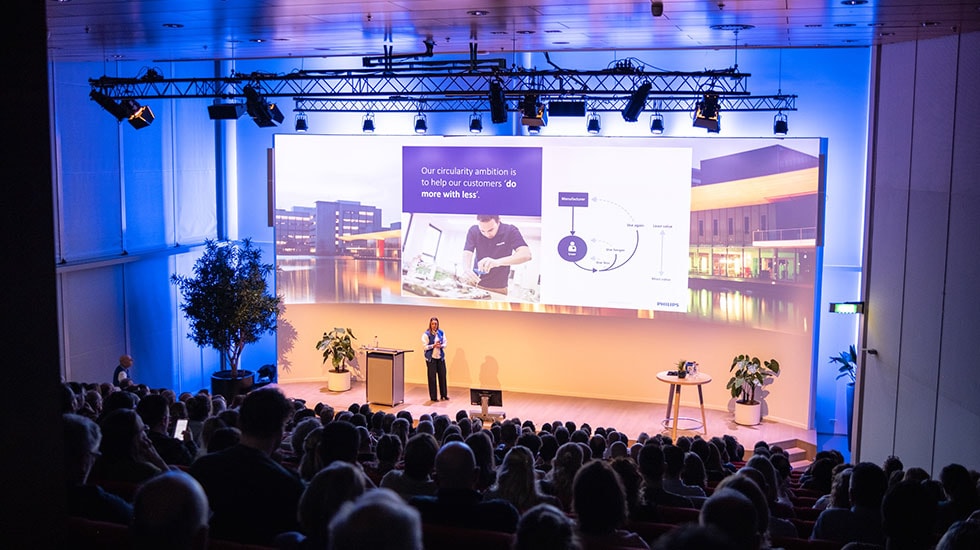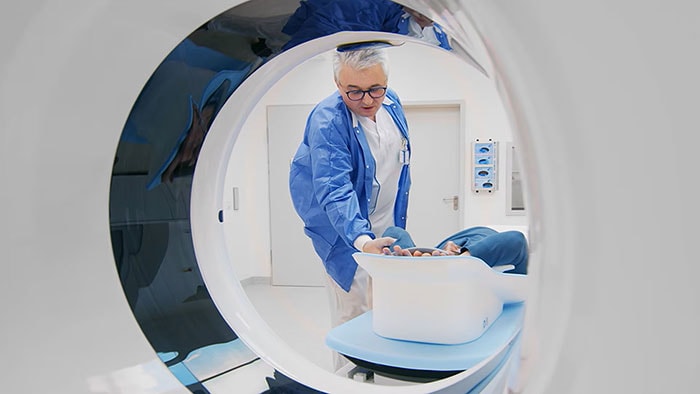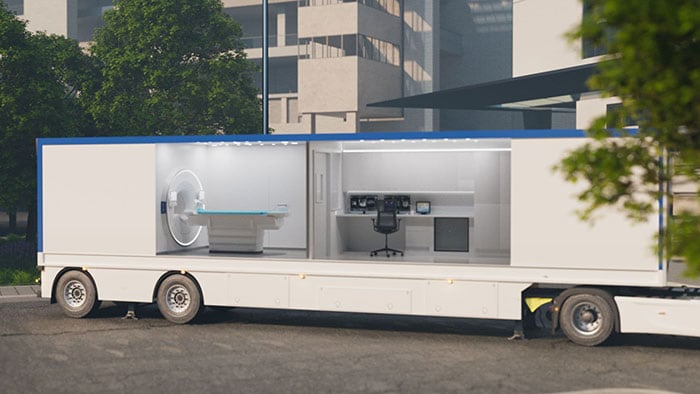Samenwerken met zorgprofessionals aan een duurzamere gezondheidszorg
mei 21, 2025 | 3 minuten leestijd
Duurzaamheid is geen bijzaak meer in de zorg. Het is een urgent thema dat vraagt om actie op meerdere vlakken, van producent tot gebruiker. Dominique Schut, onderdeel van het duurzaamheidsteam van Philips, sprak tijdens de HPM Gebruikersdag over hoe Philips duurzaamheidsdoelen vertaalt naar concrete oplossingen binnen Hospital Patient Monitoring (HPM). Van het Philips EcoDesign programma tot het terugnemen van gebruikte monitoren: duurzaamheid is integraal onderdeel van het zorgproces.

“Duurzaamheid zit in ons DNA”, opende Dominique haar sessie. “Al sinds onze oprichting werken we aan maatschappelijke impact, en sinds 1970 staat het milieu op onze agenda.” In 2022 was Philips het eerste bedrijf op het gebied van gezondheidstechnologie dat zijn hele koolstofemissiereductieplan voor de waardeketen (scope 1-3) liet goedkeuren door het Science Based Targets-initiatief (SBTi).
Een van de manieren waarop die doelen worden bereikt, is het Philips EcoDesign-programma. Dat kijkt niet alleen naar energieverbruik of verpakkingen, maar naar de hele levenscyclus van een medisch apparaat. “We ontwerpen producten met als doel: langer gebruiken, minder gebruiken en opnieuw gebruiken”, legde Dominique uit op het podium.
Philips EcoDesign is een ontwerpfilosofie die focust op de circulaire economie. Het doel is om de impact op het milieu te verkleinen door al vroeg in het innovatieproces te kijken naar energieverbruik, verpakkingen, materialen en circulariteit. Dominique: “We maken deze zaken transparant voor onze producten door te werken met ecopaspoorten, waarin de milieuprestaties van onze producten worden uitgelegd. Zo kunnen onze klanten een bewuste en weloverwogen beslissing maken.”
Verantwoord hergebruik
Een van de meest tastbare duurzaamheidsinitiatieven is het HPM TakeBack-programma. Binnen HPM worden gebruikte medische monitoren aan het einde van hun levensduur opgehaald om verantwoord te recyclen. Sinds 2018 wordt er wereldwijd gewerkt aan het ‘Close the Lop’-programma om het hergebruik van medische apparaten te stimuleren. Sindsdien worden er wereldwijd allerlei initiatieven en samenwerkingsverbanden opgezet. De Benelux was in 2024 een van de landen waar het programma, samen met HPM werd geïntroduceerd.
Samenwerken met de zorgprofessional
Hoewel Philips de producten levert, ligt er ook bij de gebruikers een sleutelrol. Dominique: “De zorgsector draagt wereldwijd ruim 4 procent bij aan de nationale CO2 emissie, in Nederland is dit zelfs 7 procent en 13 procent aan het toale grondstoffenverbruik, volgens het RIVM. Verpleegkundigen kunnen helpen dat terug te brengen door bewuster te kiezen voor herbruikbare hulpmiddelen of het juiste gebruik van apparatuur.”
En daar helpt Philips graag bij. In haar sessie wees ze op de groei van ‘Green Teams’ in ziekenhuizen, waarin zorgprofessionals duurzaamheid integreren in hun dagelijks werk. “De kracht zit in samenwerking. Als Philips kunnen we data, technologie en ondersteuning bieden, maar echte impact maken we alleen samen met jullie.”
Duurzaamheid is doen
De boodschap van Dominique is duidelijk: duurzaamheid begint niet pas bij recycling, maar al bij de eerste keuze voor een product. En ook kleine handelingen tellen mee. Minder papiergebruik, energiebesparing via stand-by-functies, of de inzet van mobiele monitoring om transport te beperken. Met de eerdergenoemde duurzaamheidsinitiatieven zet Philips concrete stappen richting een duurzamere gezondheidszorg. Of zoals Dominique het afsloot: “Duurzaamheid is niet iets wat we alleen doen binnen Philips. Het is iets wat we samen doen, binnen én buiten de zorg.”
Betere zorg voor patiënten, mensen en planeet
In 2024 bereikte Philips voor het eerst dat alle nieuwe producten (NPIs) 100% EcoDesigned waren. Deze producten sluiten aan bij de groeiende klantbehoefte om hun milieudoelstellingen te realiseren. Meer informatie is te vinden in het jaarverslag van Philips: Philips transformeert de zorg met verantwoorde en duurzame innovaties en biedt betere zorg aan meer mensen | Philips
Collaborating with healthcare professionals toward more sustainable care
Sustainability is no longer a side topic in healthcare. It is an urgent issue that requires action on multiple levels, from manufacturer to end user. Dominique Schut, part of Philips’ sustainability team, spoke at the HPM User Day about how Philips translates its sustainability goals into tangible solutions within Hospital Patient Monitoring (HPM). From the Philips EcoDesign program to the take-back of used monitors, sustainability is an integral part of the care process.

“Sustainability is in our DNA,” Dominique opened her session. “Ever since our founding, we’ve been working toward positive societal impact, and since the 1970s, the environment has been on our agenda.” In 2022, Philips became the first health technology company to have its entire carbon emissions reduction plan for the value chain (scope 1–3) approved by the Science Based Targets initiative (SBTi).
One way Philips puts these goals into practice is through the Philips EcoDesign program. This program doesn’t just focus on energy consumption or packaging but considers the entire lifecycle of a medical device. “We design products with the goal of using them longer, using fewer resources, and reusing what we can,” Dominique explained on stage.
Philips EcoDesign is a design philosophy that focuses on the circular economy. The goal is to reduce environmental impact by considering energy use, packaging, materials, and circularity early in the innovation process. Dominique: “We make these aspects transparent through ‘eco passports,’ which explain the environmental performance of our products. This allows our customers to make informed and responsible decisions.”
Responsible reuse
One of the most tangible sustainability initiatives is the HPM TakeBack program. Within HPM, used medical monitors are collected at the end of their life cycle for responsible recycling. Since 2018, Philips has been working globally on the ‘Close the Loop’ program to encourage the reuse of medical devices. Since then, various initiatives and collaborations have emerged around the world. In 2024, the Benelux was among the regions where the program was introduced in collaboration with HPM.
Working together with healthcare professionals
While Philips supplies the products, end users also play a key role. Dominique: “Globally, the healthcare sector contributes more than 4 percent to national CO2 emissions. In the Netherlands, that figure is even 7 percent, and 13 percent of total raw materials usage, according to RIVM. Nurses can help reduce this by choosing reusable tools more consciously or by using equipment correctly.”
Philips is happy to help. During her session, Dominique highlighted the growing presence of ‘Green Teams’ in hospitals, where healthcare professionals incorporate sustainability into their daily routines. “The power lies in collaboration. At Philips, we can provide data, technology, and support, but we can only make real impact together with you.”
Sustainability is action
Dominique’s message was clear: sustainability doesn’t start with recycling. It starts with the very first product choice. And even small actions count. Reducing paper use, saving energy with standby modes, or using mobile monitoring to limit transport. Through the initiatives mentioned, Philips is taking concrete steps toward a more sustainable healthcare system. As Dominique concluded, “Sustainability is not something we do alone at Philips. It’s something we do together, inside and outside the healthcare system.”
Better care for patients, people, and the planet
In 2024, Philips reached an important milestone: all new products (NPIs) were 100 percent EcoDesigned. These products align with the growing demand among customers to meet their environmental goals. More information can be found in Philips’ annual report: Philips is transforming healthcare with responsible and sustainable innovations, offering better care to more people | Philips








